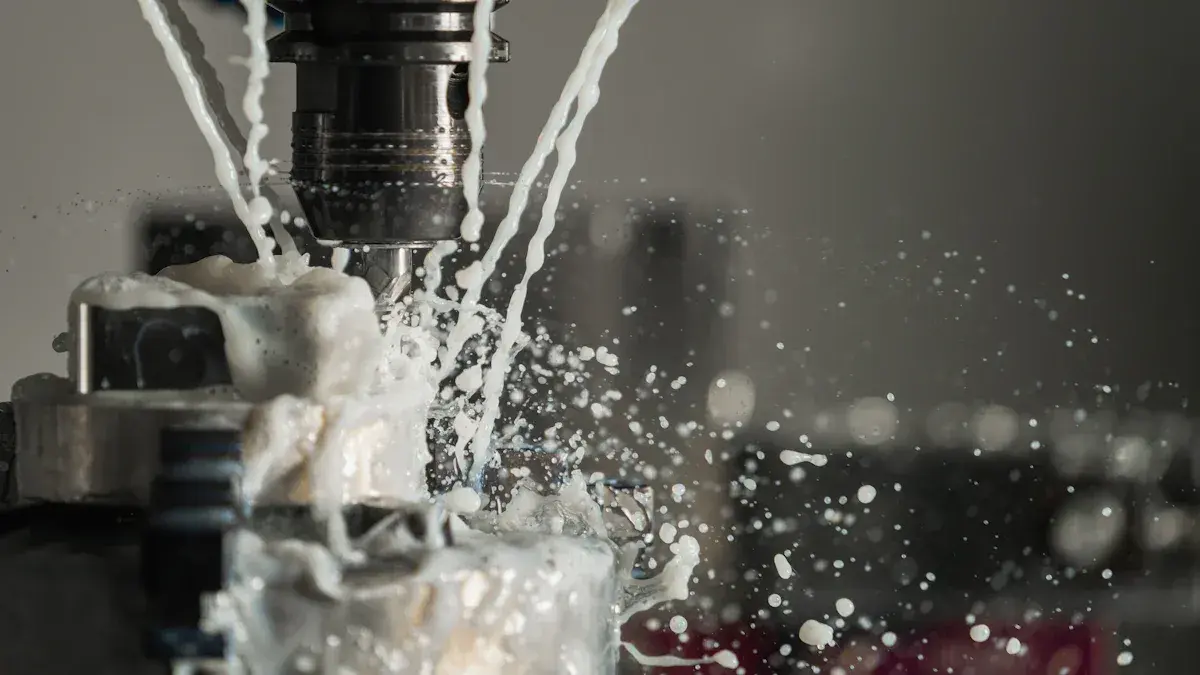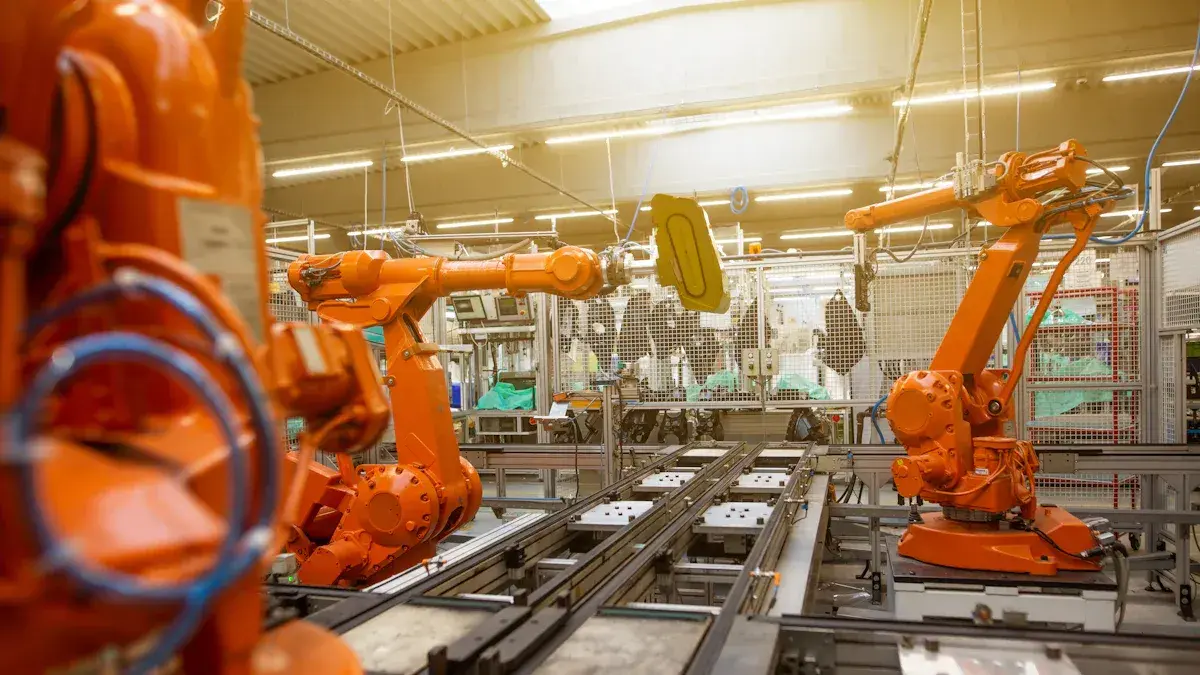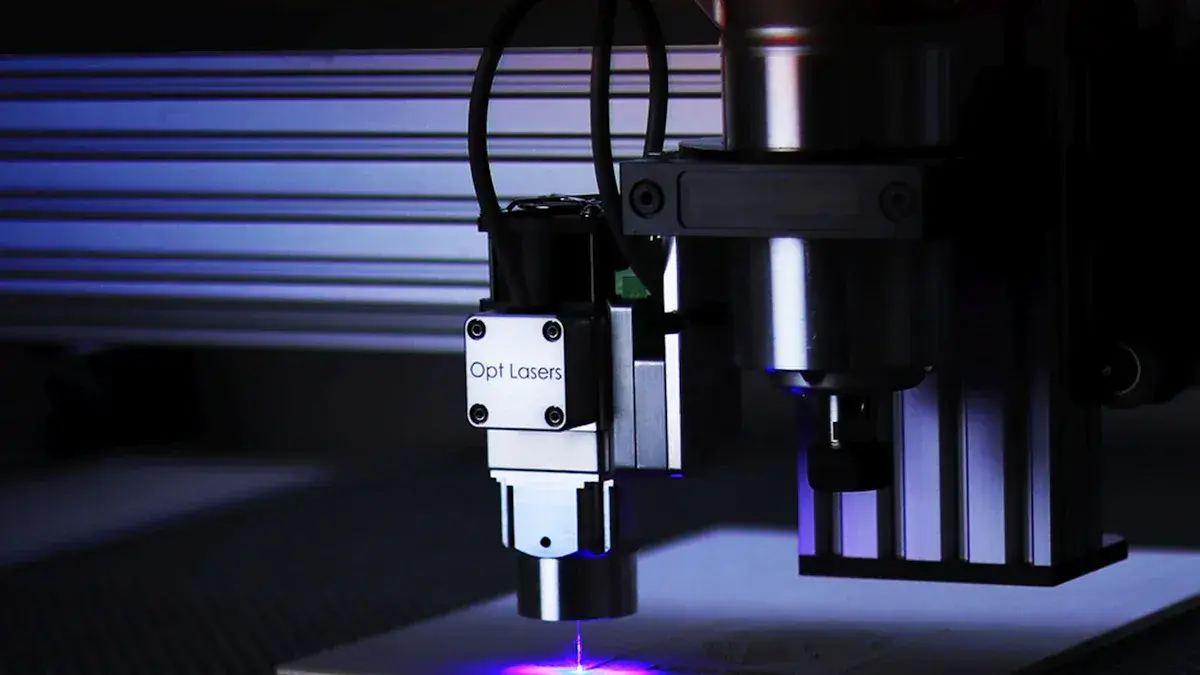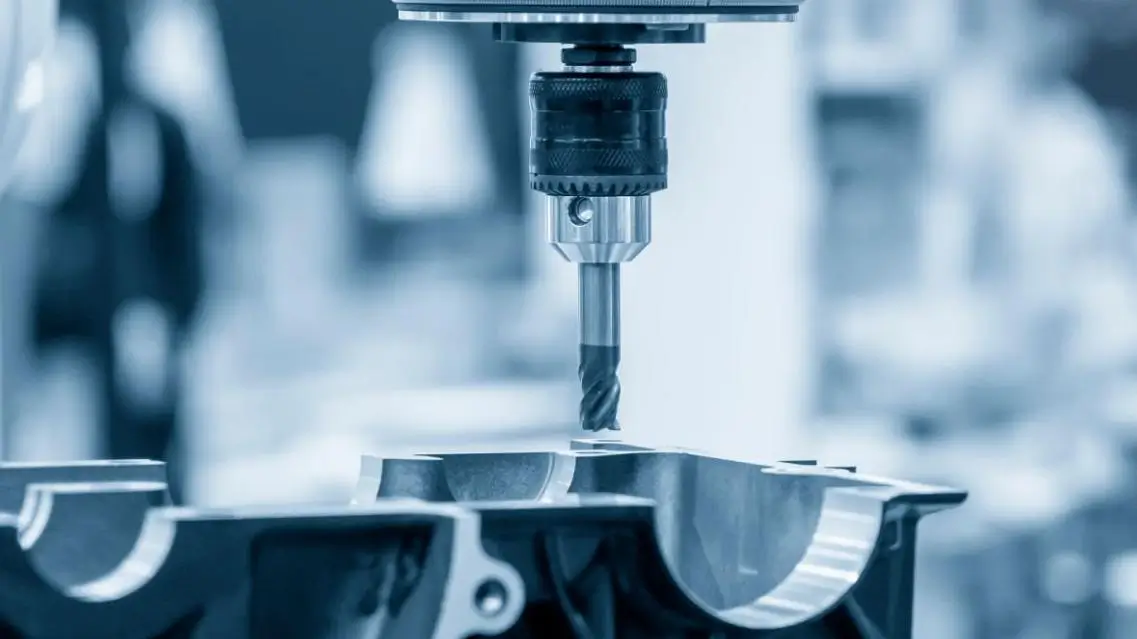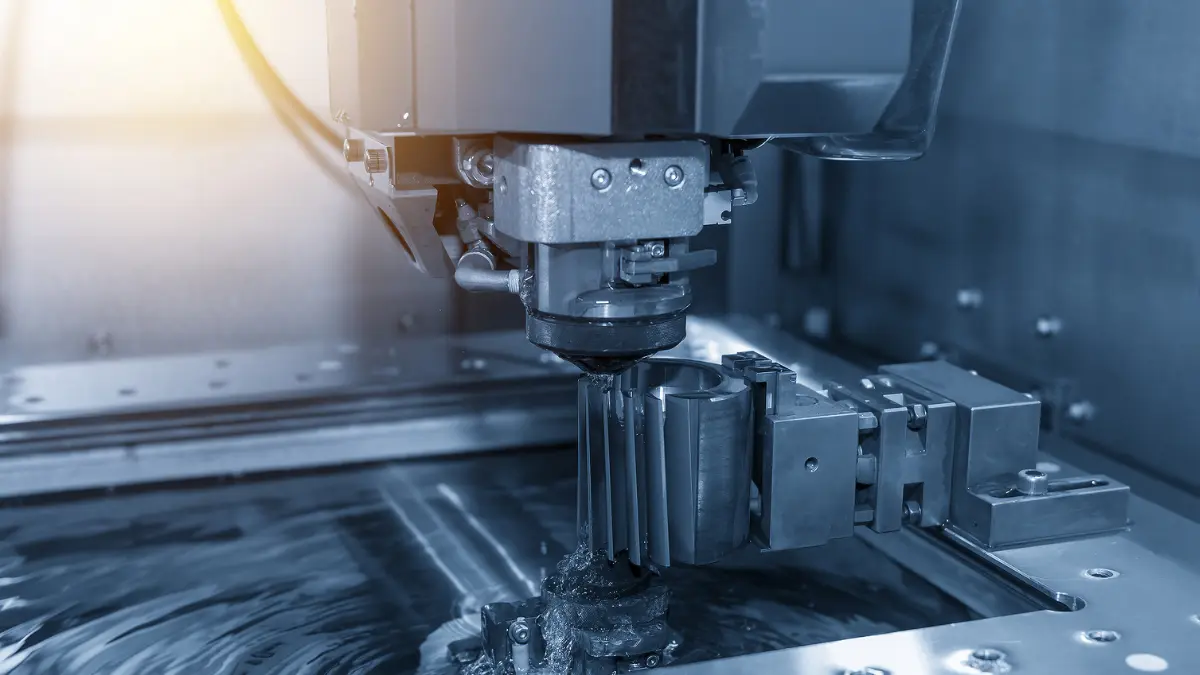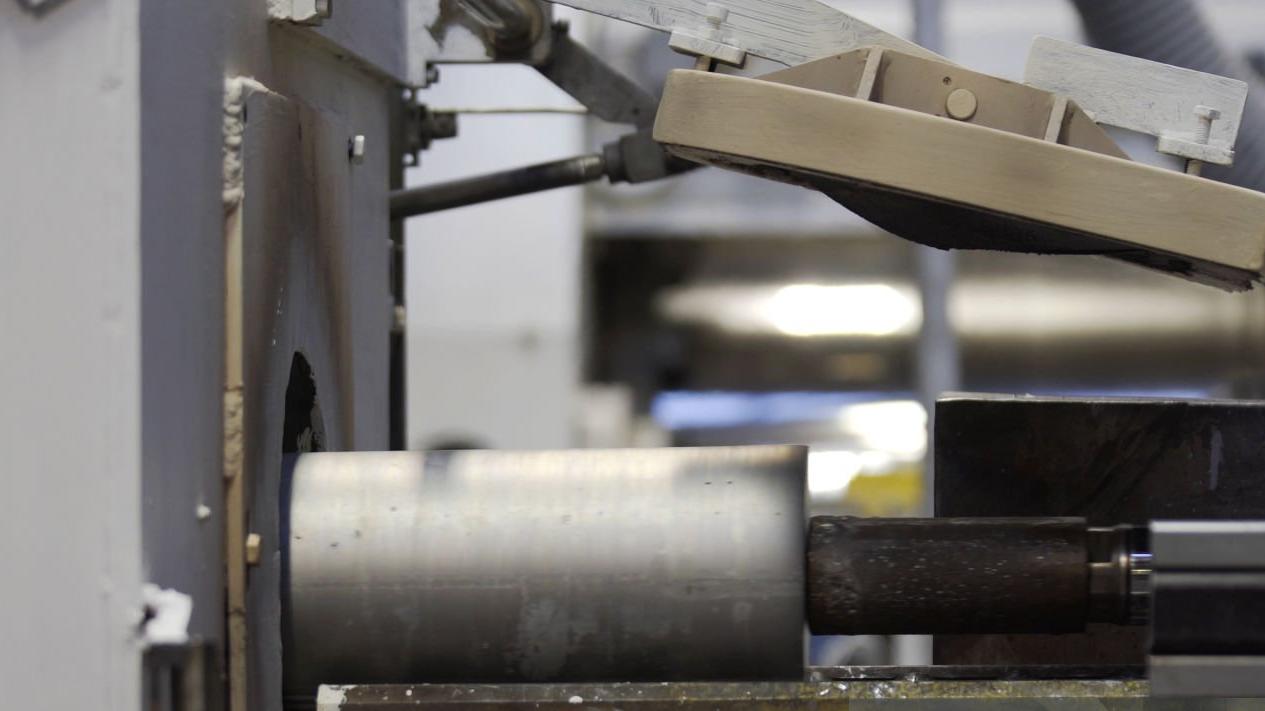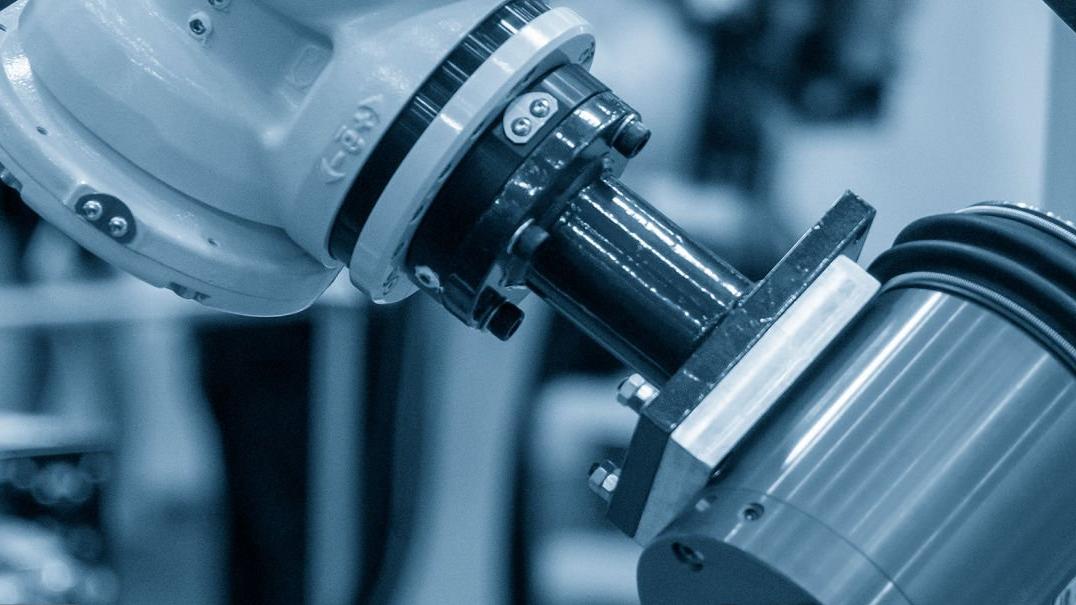CNC machining is a way to make parts using machines controlled by computers. These machines work with great accuracy and do the same job every time, better than people can by hand.
It has changed modern manufacturing in big ways. For example:
- CNC machines were worth $66.74 billion in 2023.
- By 2030, over 2,800 thousand machines will be needed, growing 10.3% each year.
This growth happens because CNC machines do hard jobs, make fewer mistakes, and work all the time. Industries like car-making and airplanes depend on them to meet high goals and create new ideas.
Key Takeaways
- CNC machining uses computers to run machines, creating parts quickly and precisely.
- Industries like airplanes and cars use CNC machines for exact production and new ideas.
- Design and manufacturing software help make work easier and faster, with fewer mistakes.
- CNC machining saves money for big projects, making each part cheaper when making more.
- Automation in CNC machining reduces mistakes, giving steady quality and less waste.
What is CNC Machining?
Definition of CNC machining
CNC machining is a way to make parts using computers. The term CNC means Computer Numerical Control. Computers guide tools like drills and mills to shape materials. This method creates parts with great accuracy and consistency. Unlike doing it by hand, CNC machining is faster and makes fewer mistakes.
It uses special programming languages like G-code and M-code. G-code tells the machine how to move, like its speed and cutting path. M-code handles extra tasks, like changing tools or cooling the machine. These codes help the machine work smoothly and efficiently.
| Parameter | Description |
|---|---|
| G-code | A code that controls how the machine moves and cuts. |
| M-code | A code that manages extra tasks like tool changes. |
| CAD/CAM Software | Helps design parts and turn designs into machine commands. |
| Machining Types | Includes tasks like drilling, milling, and turning. |
Brief history and evolution of CNC machining
CNC machining started in 1952 when MIT showed the first NC machine. During World War II, faster and more accurate machines were needed. This led to the creation of NC machines. By the 1940s and 1950s, these machines were used in industries like cars and airplanes.
In the 1980s and 1990s, CNC machines replaced older NC systems. Computers made production more precise and reduced mistakes. By the 2000s, CNC machines became cheaper, so smaller businesses could use them. Today, CNC machining is key to modern manufacturing and helps create new ideas.
Key components of a CNC system
A CNC system has many important parts that work together. These include:
- Controller: The computer that reads the program and gives commands.
- Machine tools: Tools like drills or mills that cut or shape materials.
- CAD/CAM software: Used to design parts and create machine instructions.
- Workpiece: The material that gets shaped into the final product.
- Cutting tools: Tools that remove material to create the desired shape.
CNC machining is precise, fast, and flexible. It works with many materials and is useful for different industries.
How Does CNC Machining Work?
Overview of the CNC machining process
CNC machining turns raw materials into exact parts using machines. First, you design the part with special software. Then, the design is changed into a program the machine understands. After setting up the machine, it cuts, drills, or shapes the material. This process is very accurate and repeats the same results every time. It’s great for industries needing detailed designs.
Here’s a simple table showing the steps:
| Step | Description |
|---|---|
|
1 |
Design the part |
|
2 |
Create a process plan |
|
3 |
Perform machining tasks |
|
4 |
Package and ship the product |
Each step is important to make a perfect final product.
Role of CAD (Computer-Aided Design) and CAM (Computer-Aided Manufacturing)
CAD and CAM software are key tools in CNC machining. CAD helps you draw detailed digital models of the part. CAM changes this design into instructions for the machine. This makes the process faster and easier. For example, one company cut machining time by 80% using CAD/CAM. It also reduces mistakes, improves teamwork, and boosts efficiency. Small companies save money and finish work faster. Sharing data smoothly ensures better product quality.
Steps involved in CNC machining, from programming to production
CNC machining has several main steps:
- CAD Model Design: Make a 3D drawing of the part.
- Converting the CAD File into a CNC Program: Turn the design into machine code.
- Setting Up the CNC Machine: Get tools and materials ready to use.
- Executing the Machining Operation: The machine makes the part by following the code.
Studies show CNC machining is very accurate. Predicted times match real times 97% of the time. Automation tools track downtime and production data. These tools make the process smooth and reliable.
Types of CNC Machines
CNC machines come in different types for specific tasks. Knowing these types helps you pick the right one. Here are three common ones: CNC milling machines, CNC lathes, and CNC routers.
CNC Milling Machines
CNC milling machines cut and shape materials with spinning tools. They are great for making detailed parts with high accuracy. For example, they can work within ±0.002 mm precision. This makes them useful in industries like aerospace and medical fields. They create shapes that hand tools cannot make.
The material used affects how the machine works. Harder materials, like titanium, need more force and wear tools faster. Modern CNC milling machines handle these challenges well. They keep precision at 0.01 mm, even for large production runs.
| Machine Type | Cost Range | Best For |
|---|---|---|
| Benchtop CNC Mill | $3,000–$15,000 | Prototyping, small metal parts |
| Industrial CNC Mill (3-axis) | $25,000–$100,000 | General metal production |
| 5-axis CNC Mill | $100,000–$500,000+ | Aerospace, medical implants |
CNC Lathes
CNC lathes make round parts by spinning material while cutting it. They are perfect for making screws, bolts, and shafts. These machines are efficient and reliable. They produce fewer defective parts, saving time and money.
For example, CNC lathes have low rejection rates, meaning fewer bad parts. This makes them great for industries needing many parts quickly. They also work with different materials like metals and plastics.
| Metric | Description |
|---|---|
| Rejection Rate | Fewer defective parts improve overall efficiency. |
| Part Quality Rate | High-quality output ensures consistent performance. |
| Cost per Part | Lower costs indicate better production efficiency. |
CNC Routers
CNC routers cut and shape softer materials like wood and plastic. They are used in woodworking, sign-making, and even aerospace. These machines make custom parts quickly and accurately.
For example, CNC routers help shape granite and marble with precision. They are also great for testing designs and creating prototypes. This helps bring ideas to life faster.
| Machine Type | Cost Range | Best For |
|---|---|---|
| Desktop CNC Router | $1,000–$5,000 | Hobbyists, small craft businesses |
| Industrial CNC Router | $15,000–$80,000 | Professional woodworking |
| 5-axis Wood CNC Router | $50,000–$150,000+ | Complex, artistic woodworking |
CNC routers are fast and accurate. They are useful for both small projects and big manufacturing jobs.
CNC Plasma Cutters
CNC plasma cutters use super-hot plasma to cut metals like steel, aluminum, and copper. These machines are great for industries needing fast and accurate cutting, such as car-making, construction, and metalwork.
These cutters are very efficient because they handle tough cutting jobs automatically. Automation lowers labor costs and reduces mistakes, making the work more consistent. Special software helps use materials wisely, cutting down on waste and saving money. Robots can also work with CNC plasma cutters to adjust cutting paths in real-time. This teamwork reduces waste and boosts productivity.
Here are some main benefits of CNC plasma cutters:
- Lowered operating costs: Robots replace workers, saving money and energy.
- Increased production output: They work nonstop, making more products faster.
- Improved part quality: Automation ensures parts are precise and consistent.
- Reduced lead times: Better control speeds up production times.
CNC plasma cutters can cut different materials and thicknesses. Whether for small designs or big projects, they deliver dependable results.
CNC Grinders and CNC EDM Machines
CNC grinders and CNC EDM machines are known for their precision and speed. CNC grinders use spinning abrasive wheels to shape materials. They are great for smooth finishes and detailed shapes. Modern grinders have advanced software and tools that make them faster and easier to use. Automated setups help create complex designs quickly.
CNC EDM machines use electric sparks to cut hard materials like titanium and carbide. They are perfect for making detailed molds and tools. These machines stay accurate even when working fast, similar to CNC grinders. Both machines are vital for industries like aerospace, medical tools, and toolmaking, where accuracy is very important.
Using these machines helps you save time and resources while achieving excellent results.
Benefits of CNC Machining
Precision and accuracy
CNC machining is very precise, perfect for exact part-making. It creates parts with the same quality every time. High-speed machines stay accurate, even during long production runs. They ensure tools and systems work without errors.
- Cutting is 3 to 8 times faster than old methods.
- Cutting force is 30% less, helpful for thin materials.
- Accuracy stays high, giving reliable results for years.
This precision reduces mistakes and waste, saving time and money.
Efficiency and speed
CNC machines work fast and improve production. They run nonstop, helping meet tight deadlines. High-speed cutting also makes tools last longer, saving costs.
Automation helps by removing the need for manual work. This lowers human mistakes and keeps output consistent. It’s easier to make more products while keeping quality high.
Versatility in materials and designs
CNC machines handle many materials and designs. They work with metals like aluminum or plastics like ABS. Here’s a simple table:
| Material Type | Examples | Uses |
|---|---|---|
| Metals | Aluminum, Steel | Cars, Airplanes |
| Plastics | ABS, Polycarbonate | Gadgets, Medical Tools |
CAD software helps create detailed designs easily. Complex designs may cost more, but simpler ones save time. CNC machining is key for industries needing precision and flexibility, like aerospace and medical tools.
Cost-effectiveness in large-scale production
CNC machining saves money when making many parts. The cost per part drops as you make more. This is because setup and programming costs are shared across all parts. For instance, one setup can create thousands of identical pieces, lowering the total cost.
Buying materials in bulk also saves money. Large orders often come with discounts. CNC machines work quickly and with little downtime, making production efficient. These factors make CNC machining a great choice for big manufacturing jobs.
Using lean methods makes it even cheaper. Cutting waste and improving processes lowers costs over time. New CNC technology, like faster cutting and stronger tools, adds to these savings.
| Evidence | Description |
|---|---|
| Economies of Scale | Making more parts spreads fixed costs over many units. |
| Volume Discounts | Buying materials in bulk lowers costs and boosts efficiency. |
| Continuous Improvement | Lean methods cut waste and improve processes to save money. |
CNC machining gives you quality parts at lower prices, especially for large orders. It’s a smart tool for staying competitive in manufacturing.
Reduced human error and waste
CNC machining cuts down on mistakes by using automated systems. Machines follow exact instructions, so parts turn out the same every time. This reduces errors that could ruin parts. For example, automated setups remove mistakes caused by manual work.
Advanced CNC machines adjust in real-time. Sensors check the process and fix issues instantly. This ensures every part meets the right standards. With this precision, less material is wasted, saving money and resources.
| Evidence | Description |
|---|---|
| Reduced Scrap Rates | CNC machines can lower wasted material by up to 25%. |
| Real-time Adjustments | Sensors and AI fix problems during production for better results. |
| Improved Precision | Automated setups reduce errors and make parts more accurate. |
By cutting waste and errors, CNC machining saves money and helps the environment. This technology ensures high-quality parts while using fewer materials.
Applications of CNC Machining in Modern Manufacturing
Aerospace industry
CNC machining is very important in the aerospace field. Companies like Boeing and Airbus use CNC machines to make airplane parts. These include wings, fuselages, and lightweight structures. The parts improve fuel use and flight performance. SpaceX also uses CNC machines for rocket parts. These parts are reusable and help lower space travel costs.
This technology speeds up testing and small production runs. Engineers can quickly improve designs using CNC machining. It also meets strict aerospace rules like AS9100. These rules require accuracy and traceable production. CNC machining reduces waste and uses materials wisely. This keeps costs low while meeting safety standards.
Automotive industry
The car industry uses CNC machines for precise and fast production. CNC machines make engines, transmissions, and electric car parts. Electric cars need lighter parts, increasing CNC machine use. CNC machining helps improve car efficiency and reduce weight.
Studies show better CNC settings improve part quality and speed. Faster production saves time and ensures consistent results. Advanced CNC machines now use IoT and AI. These tools make processes faster and more productive.
Medical device manufacturing
CNC machining is key for making accurate medical devices. It ensures tools and implants meet exact size needs. This is important for safe and effective surgeries. CNC machines make sure medical tools work perfectly.
CNC machining follows strict rules like ISO 13485. These rules focus on quality and reducing risks. Machines create reliable parts with no errors. They are also great for testing new designs. This helps medical companies create safe and innovative devices.
Electronics and consumer goods
CNC machining is important for electronics and consumer goods. It makes precise parts for items like phones, laptops, and appliances. These machines ensure every piece fits perfectly, which is key for reliable devices.
You can check how CNC machining improves quality with these measures:
| Metric | Description |
|---|---|
| Overall Equipment Effectiveness (OEE) | Measures machine efficiency by checking availability, speed, and quality. |
| Defect Density | Counts product defects to fix quality problems quickly. |
| First Pass Yield | Tracks products that meet standards on the first try, showing accuracy. |
Tracking these helps find problems early and improve production. CNC machining also allows for complex designs, helping create advanced products. Whether it’s a slim phone case or a strong appliance part, CNC ensures precision and quality.
Tip: CNC machining reduces defects and boosts efficiency, saving time and money.
Custom and prototype manufacturing
CNC machining is great for custom and prototype manufacturing. It makes small batches of parts quickly and accurately, which is helpful for testing new ideas. This technology lets you refine designs before mass production.
Modern CNC machines create prototypes that look and work like final products. This speeds up development and ensures designs meet real needs. For example, industries like aerospace, cars, and medical tools use CNC for custom parts.
- CNC machining is perfect for small runs during product testing.
- Advanced tools let you make prototypes earlier in the design phase.
- Prototypes help find and fix design issues before large-scale production.
Using CNC machining brings ideas to life faster and more accurately. This helps companies innovate and stay ahead in competitive industries.
CNC machining has changed manufacturing by offering amazing accuracy and speed. It allows creating detailed designs and shapes that were hard to make by hand. This technology is now essential for industries like cars, airplanes, and medical tools. It helps make products faster and ensures high quality.
In the future, smarter machines with AI will improve CNC machining. They will make better designs, check data instantly, and know when repairs are needed. By 2026, the market could grow to $129 billion because of more demand in areas like defense and aviation. These changes will boost production and create new ways to manufacture.
Tip: Using these new technologies will keep you ahead and ready for modern industry needs.
FAQ
What materials can CNC machines work with?
CNC machines can work with many materials. These include metals like aluminum and steel, plastics like ABS, and even wood or ceramics. The material you pick depends on what your project needs, like strength or heat resistance.
How accurate are CNC machines?
CNC machines are very precise, often reaching tolerances of ±0.002 mm. This accuracy ensures parts are made the same every time. It’s great for industries like aerospace and medical tools where exact sizes matter.
Can CNC machines create complex designs?
Yes, CNC machines are great for making detailed designs. With CAD software, you can create complex parts. The machine copies the design perfectly. This makes CNC machining ideal for prototypes, custom parts, and advanced projects.
Is CNC machining cost-effective for small projects?
CNC machining can save money on small projects like prototypes. While setup costs might be high, the speed and accuracy of CNC machines make up for it. They save time and reduce mistakes, which lowers overall costs.
Do CNC machines require human supervision?
CNC machines mostly run on their own but still need people. You have to program them, set up materials, and check the process. Regular care keeps the machine working well.
Tip: Always check your program carefully to avoid mistakes during production.

